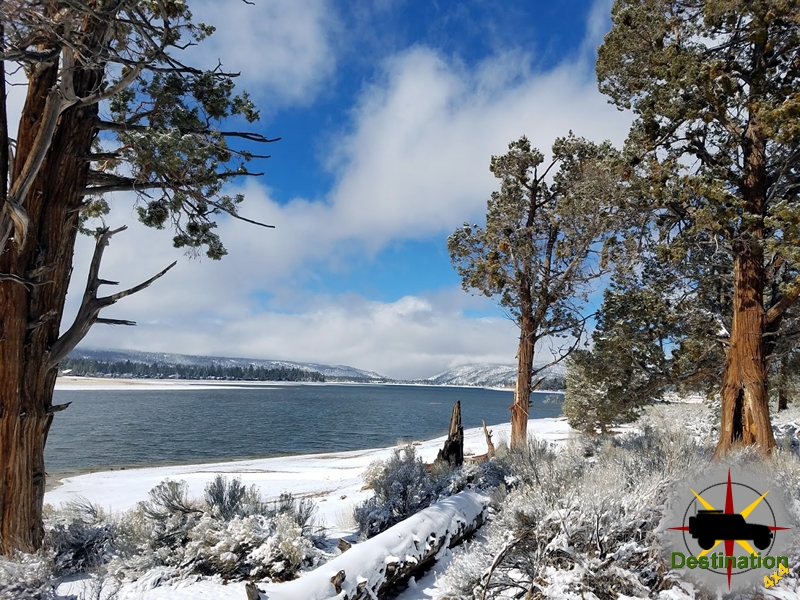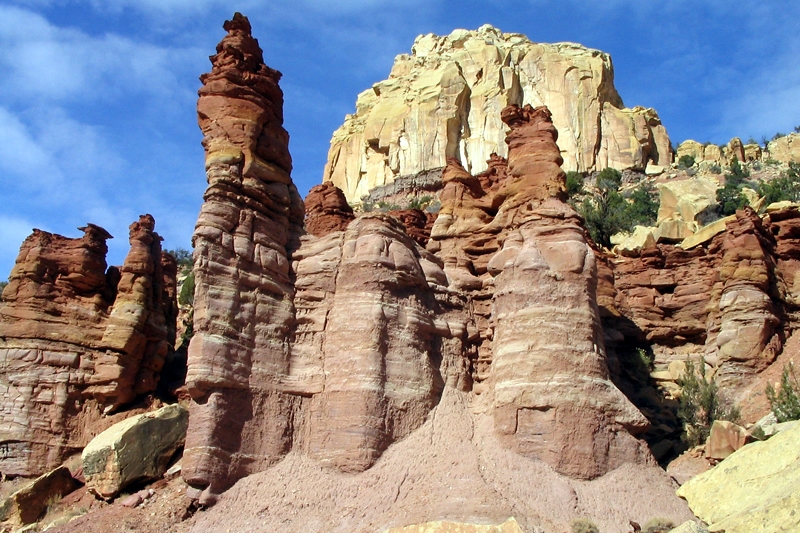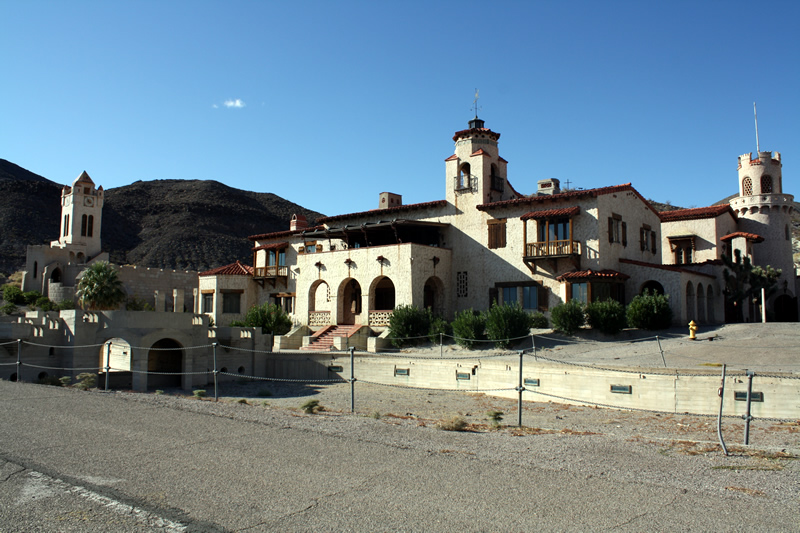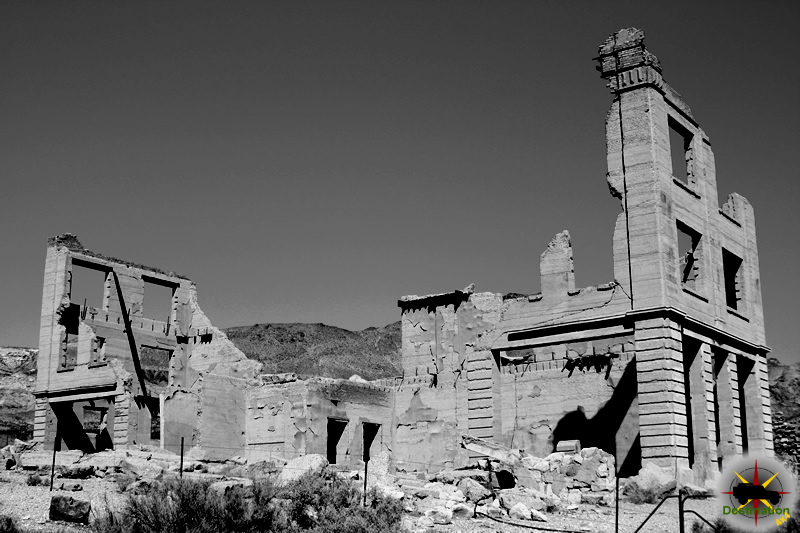
Belleville California – San Bernardino County Ghost Town

Belleville is a historic community located in the Holcomb Valley region of San Bernardino County, California. The area’s history dates back to the mid-19th century when it played a significant role in the California Gold Rush.
Holcomb Valley, where Belleville is situated, was discovered to be rich in gold deposits in 1860. The news quickly spread, and a gold rush ensued as prospectors from all over flocked to the area in search of their fortunes. The population of the valley boomed, and various mining camps and settlements sprang up, including Belleville.
Belleville was founded in 1860 and named after James V. Belleville, one of the early prospectors in the area. The town rapidly grew and became a central hub for the Holcomb Valley mining district. It served as a supply center for nearby mining operations, providing essential goods and services to miners and their families.
The town boasted several businesses, including general stores, saloons, hotels, and blacksmith shops. It also had a post office, which opened in 1863. Belleville’s population reached its peak during the 1860s, with estimates ranging from a few hundred to over a thousand residents.

Mining was the primary economic activity in Belleville and the surrounding Holcomb Valley. Miners used various methods to extract gold from the area, including placer mining and hydraulic mining. Placer mining involved using pans, rockers, and sluices to separate gold from the gravel and sand of the valley floor. Hydraulic mining utilized high-pressure water jets to wash away hillsides and expose gold-bearing gravels.
However, the gold production in Holcomb Valley began to decline in the late 1860s, and by the 1870s, many miners had moved on to other gold fields. As the gold rush subsided, so did the population of Belleville. The town gradually declined, and most of its buildings were dismantled or moved to other locations.
Today, little remains of Belleville and the once-thriving mining operations of Holcomb Valley. Some remnants of mining structures, such as mine shafts and tunnels, can still be found in the area. The site of Belleville itself is marked by a historical marker, providing a glimpse into the region’s rich mining heritage.

Belleville Town Summary
| Name | Belleville |
| Location | Holcomb Valley, San Bernardino, CA |
| Latitude, Longitude | 34.3012, -116.8857 |
| Elevation | 7,355 Feet |
| GNIS | |
| Population | 1,500 |
| Gold Fever Trail Marker | 7 |
Belleville Trail Map
References
Holcomb Valley Ranch

Holcomb Valley Ranch is a historic region located in the San Bernardino Mountains of Southern California, United States. It has a rich history that dates back centuries and has played a significant role in the development of the region.
Holcomb Valley Ranch is a picturesque and historic destination nestled in the heart of the San Bernardino Mountains in Southern California. This sprawling ranch, encompassing an area of breathtaking natural beauty, offers visitors a glimpse into the rich cultural heritage and rustic charm of the region.
Surrounded by towering pine trees and rugged mountain peaks, Holcomb Valley Ranch provides a tranquil and idyllic retreat from the hustle and bustle of city life. The ranch’s landscape is characterized by rolling hills, expansive meadows, and meandering streams, creating a serene and captivating atmosphere.
Steeped in history, the ranch holds a significant place in the annals of the American West. It was originally settled during the mid-1800s as a bustling mining community during the California Gold Rush. Today, remnants of the past can still be found in the form of restored log cabins, mining equipment, and other artifacts that serve as a testament to the area’s rich mining heritage.
Visitors to Holcomb Valley Ranch have the opportunity to immerse themselves in a variety of outdoor activities. The surrounding wilderness offers ample opportunities for hiking, horseback riding, and mountain biking, allowing visitors to explore the rugged beauty of the San Bernardino Mountains. Fishing enthusiasts can cast their lines in the nearby streams and lakes, while nature lovers can indulge in birdwatching and wildlife spotting.
For those seeking a taste of the Old West, the ranch offers a range of authentic experiences. Guests can saddle up and embark on guided horseback rides, traversing scenic trails and taking in panoramic views. They can also try their hand at gold panning, reliving the excitement of the Gold Rush era.
Accommodations at Holcomb Valley Ranch cater to a variety of preferences. Rustic cabins provide a cozy and comfortable retreat, complete with modern amenities, while campsites allow visitors to fully immerse themselves in the natural surroundings. The ranch also offers facilities for hosting weddings, corporate retreats, and other special events, providing a charming and memorable setting.
Whether seeking a peaceful getaway, an adventure in the great outdoors, or a journey back in time, Holcomb Valley Ranch is a place where nature, history, and relaxation converge. It offers a unique opportunity to experience the beauty of the San Bernardino Mountains while embracing the spirit of the Old West.
Trail Map
Campground Summary
| Name | Hidden Valley Ranch |
| Location | Holcomb Valley, Big Bear, San Bernardino, California |
| Latitude, Longitude | 34.2976, -116.9123 |
| Number of Sites |
References
White Crack Campground

White Crack Campground is a remote backcountry camping area in Canyonlands National Park’s Island in the Sky district, located along the White Rim Trail. This single campsite, accommodating up to three vehicles and 15 people, is one of the most isolated and scenic along the trail, offering unparalleled views of the Maze, Needles, and Island in the Sky districts. Perched at approximately 4,500 feet elevation, the site features expansive vistas of dramatic red rock formations, deep canyons, and distant mesas, with Candlestick Tower and the Colorado River’s gooseneck bends visible on clear days. The campground is primitive, with no potable water, shade, or wind protection, requiring campers to bring all supplies, including at least 1 gallon (4 liters) of water per person per day. A vault toilet is available, but reviews note it can be odor-prone in warmer months. The terrain is rocky and uneven, suitable for tents but challenging for securing stakes due to the hard ground. Stargazing is exceptional due to the remote location and minimal light pollution, with campers describing the night sky as “otherworldly.” Access requires a high-clearance 4×4 vehicle, as the road to White Crack is rugged and unsuitable for standard vehicles or large trucks with campers (e.g., Ford F-350 with oversized campers). Overnight permits are required, costing $36 for the reservation plus $5 per person per night, and are highly competitive, especially in spring and fall. The site’s isolation and proximity to trail’s end make it a coveted spot for those seeking solitude.
White Rim Trail
The White Rim Trail is a legendary 100-mile loop in Canyonlands National Park’s Island in the Sky district, renowned for its challenging terrain and jaw-dropping desert scenery. This high-clearance 4×4 route, also popular among mountain bikers, follows the “white rim” ledge between the mesa top and the Green and Colorado Rivers below, offering sweeping views of red rock canyons, buttes, and river valleys. Notable highlights include Gooseneck Overlook, Musselman Arch, White Crack (with its panoramic views of three park districts), and Murphy Hogback, which provides 360-degree vistas. The trail’s terrain varies from wide dirt roads to sandy stretches and technical jeep trails with cliff exposure, particularly at Shafer Trail, Lathrop Canyon Road, Murphy Hogback, Hardscrabble Hill, and Mineral Bottom switchbacks. With an elevation gain of about 9,160 feet, the route is moderately difficult for vehicles and strenuous for cyclists, typically taking 2-3 days to complete, though experienced bikers may attempt it in a single day. Permits are required for both day-use and overnight trips, with 20 designated campsites across 10 areas, including White Crack Campground. No potable water is available, and high water on the Green River (May-June) can flood western sections, potentially preventing a full loop. The best times to visit are spring (March-May) and fall (September-November) for milder temperatures and stable weather, as summer brings extreme heat and winter may bring closures.
Camp 4

Camp 4 Campground, located in the heart of Yosemite Valley at 4,000 feet elevation, is a historic and iconic campground in Yosemite National Park, renowned as a mecca for rock climbers and a budget-friendly option for adventurers. With 35 shared tent-only sites accommodating up to six people each, Camp 4 operates on a first-come, first-served basis year-round, with a lottery system during peak season (May 22–September 30). Its compact, walk-in layout and communal atmosphere set it apart from the reservation-based Upper, Lower, and North Pines campgrounds. Situated near Yosemite Falls, Camp 4 offers a unique blend of history, affordability, and proximity to the valley’s iconic landmarks, though its lack of privacy and limited amenities may not suit everyone. Below is a detailed review of its setting, amenities, accessibility, and overall experience, paired with a vivid description of the Yosemite Valley floor.
Description of Yosemite Valley Floor
Yosemite Valley, the stunning backdrop for Camp 4, is a glacial-carved wonder stretching roughly 7 miles long and 1 mile wide at 4,000 feet elevation. Framed by towering granite cliffs, the valley floor is a breathtaking tapestry of natural beauty. The Merced River winds gently through its center, reflecting the surrounding peaks and adding a serene ambiance. Iconic landmarks define the landscape: Half Dome’s sheer granite face rises dramatically to the east, El Capitan’s massive monolith looms to the west, and Yosemite Falls, one of North America’s tallest waterfalls, cascades with peak flow in spring, its roar audible from Camp 4.
The valley floor blends dense forests of Ponderosa pine, California black oak, and white fir with open meadows like Cooks Meadow, which burst with wildflowers in spring and early summer. These meadows attract wildlife, including mule deer, squirrels, and occasionally black bears, adding to the valley’s allure. Approximately 12 miles of paved bike paths and hiking trails crisscross the flat terrain, ideal for exploration by foot or bike. Landmarks like Glacier Point, accessible by a short drive, offer panoramic views of Half Dome, Clouds Rest, and the Sierra Nevada. The valley’s beauty shifts with the light—golden hues illuminate the cliffs at sunset, while morning mists create a mystical atmosphere. Summer crowds, however, can congest trails and shuttle stops, especially near Yosemite Village.
Campground Details
Location and Accessibility
Camp 4 is located on the north side of Yosemite Valley, near the Yosemite Valley Lodge and the base of Yosemite Falls, making it a prime spot for climbers tackling nearby routes like El Capitan and Swan Slab. The campground is reachable via Highway 41 from Fresno, Highway 140 from Merced, or Highway 120 from Manteca, with clear signage guiding visitors to Yosemite Valley. A free shuttle bus stops nearby at the Yosemite Valley Lodge, connecting campers to key attractions like Curry Village, Yosemite Village, and trailheads, reducing the need for driving. The campground is a short walk from the Lower Yosemite Fall trailhead, offering easy access to one of the park’s most popular hikes.
As a walk-in campground, Camp 4 requires campers to park in a shared lot and carry gear a short distance (50–100 yards) to sites. There are no designated wheelchair-accessible sites, and the uneven terrain and lack of paved paths may pose challenges for those with mobility issues. Restrooms are accessible, but the campground’s rustic nature limits overall accessibility compared to Upper, Lower, or North Pines.
Amenities
Each of Camp 4’s 35 sites includes a fire ring with grill, a shared bear-proof food storage locker (33”D x 45”W x 18”H), and access to picnic tables in communal areas. The campground provides flush toilets and drinking water but lacks showers, laundry facilities, or hook-ups for RVs, as it is tent-only. Showers are available at Curry Village or Housekeeping Camp, a 15–20-minute walk or short shuttle ride away. A general store, restaurants, and an activities desk at Yosemite Valley Lodge or Curry Village meet additional needs, such as groceries or tour bookings. A free dump station is available near Upper Pines, about a mile away, though irrelevant for Camp 4’s tent-only setup.
Campsite Layout and Privacy
Camp 4’s sites are arranged in a compact, walk-in layout within a forested area of Ponderosa pines, offering shade but minimal privacy. Sites are shared, with up to six people per site, often strangers, fostering a communal, social atmosphere. “It’s like a climber’s hostel—expect to make friends,” noted a reviewer (The Dyrt, 2021). Sites are closely spaced, with little separation between tents, and noise from neighboring campers or nearby Yosemite Falls can be noticeable. Some sites near the perimeter offer slightly more space, but the overall layout prioritizes efficiency over seclusion. The campground’s historic vibe, with boulder-strewn grounds and climbing gear strewn about, adds to its unique charm.
RV and Tent Camping
Camp 4 is exclusively for tent camping, with no RV or trailer accommodations. Each site allows up to six people, with gear carried from the parking lot to the site. The parking lot accommodates two vehicles per site, with overflow parking available nearby at Yosemite Valley Lodge. Generator use is irrelevant, as the campground caters to a low-tech, tent-based experience.
Reservation and Cost
Camp 4 operates on a first-come, first-served basis year-round, with a daily lottery system during peak season (May 22–September 30). From 8:30 AM, campers register at the kiosk for a lottery drawn at 9:00 AM, assigning sites for that day. The cost is $6 per person per night, making it one of Yosemite’s most affordable options. Outside peak season, sites are first-come, first-served without a lottery, but arriving early (by 6–7 AM) is essential, as spots fill quickly. “We lined up at 5:30 AM and still barely got a site,” reported a camper (Yelp, 2025). A waitlist is available at the kiosk for cancellations, but patience is required. The campground remains open in winter, with fewer sites available due to snow.
Activities and Attractions
Camp 4’s location is a climber’s paradise, with bouldering opportunities and climbing routes like Swan Slab and Glacier Point Apron nearby. The Lower Yosemite Fall trail, a 1-mile roundtrip, is a short walk away, and trails to Upper Yosemite Fall (7.2 miles roundtrip) and Glacier Point are accessible by foot or shuttle. The valley’s 12 miles of paved bike paths make cycling a popular way to explore, with rentals available at Yosemite Valley Lodge or Curry Village. Rafting on the Merced River is an option in summer, and ranger-led programs, including climbing talks and naturalist walks, are offered nearby. Yosemite Village, a short shuttle ride away, houses a museum, art center, and visitor center. The campground’s historic significance—listed on the National Register of Historic Places for its role in climbing culture—adds a unique draw, with climbers often sharing stories around communal fire rings.
Wildlife and Safety
Yosemite Valley is rich with wildlife, including black bears, mule deer, and raccoons, requiring strict food storage protocols. All food, toiletries, and scented items must be stored in shared bear-proof lockers, not vehicles or tents, to prevent bear encounters. “Bears are active here—don’t skip the lockers,” warned a camper (Campendium, 2023). Rangers enforce compliance with citations, and bear sightings are common, especially at night. Trash must be disposed of in bear-proof dumpsters, and recycling stations support the park’s zero-landfill goal. The 4,000-foot elevation may affect those sensitive to altitude, and weather ranges from warm summers (70–90°F) to cold spring and fall nights (30–50°F), with snow possible in winter. Check forecasts, as rain or early snow can impact tent camping.
Campground Map
Camper Feedback
Positives
- Location: Campers love Camp 4’s proximity to Yosemite Falls and climbing routes. “It’s a climber’s dream—steps from bouldering and trails,” said a reviewer (Hipcamp, June 2025).
- Affordability: At $6 per person per night, it’s a budget-friendly option. “Cheapest way to stay in the valley,” noted a camper (The Dyrt, 2021).
- Community: The shared-site setup fosters a unique social vibe. “Met amazing climbers from all over the world,” shared a reviewer (Yelp, 2025).
- Scenery: The forested setting and views of Yosemite Falls are highlights. “Falling asleep to the sound of the falls is unreal,” said a camper (Tripadvisor, 2024).
Negatives
- Crowding and Noise: The shared sites and compact layout mean zero privacy. “You’re basically camping on top of strangers,” complained a camper (The Dyrt, 2020). Noise from climbers or Yosemite Falls can disrupt sleep.
- No Reservations: The first-come, first-served system is stressful. “Waiting in line at 5 AM for the lottery is brutal,” noted a reviewer (Campendium, 2023).
- Limited Amenities: No showers or laundry on-site and shared lockers can be inconvenient. “You’re roughing it here,” said a camper (Yirono
- Bear Activity: Frequent bear visits require vigilance. “A bear got into a neighbor’s tent—use the lockers!” warned a reviewer (The Dyrt, 2021).
Tips for Campers
- Arrive Early: Line up by 5–6 AM for the lottery or off-season first-come, first-served sites, especially in summer. Bring a warm drink for the wait.
- Pack Light: Walk-in sites require carrying gear, so minimize heavy equipment. A cart or backpack is helpful.
- Bear Safety: Store all scented items in shared lockers and consider a padlock for security. Never leave food unattended.
- Bring Bikes: Bikes are ideal for navigating the valley’s paved paths. “Biking saved us from crowded shuttles,” said a reviewer (Tripadvisor, 2025).
- Plan for Weather: Pack for variable weather, including rain gear and warm layers for cool nights, especially in spring, fall, or winter.
- Embrace the Vibe: Be prepared for a social, communal experience. Bring earplugs for noise and a friendly attitude for shared sites.
Overall Experience
Camp 4 Campground offers a unique, budget-friendly Yosemite experience steeped in climbing history and communal spirit. Its location near Yosemite Falls and climbing routes, combined with stunning valley views, makes it a favorite for adventurers willing to embrace its rustic, social setup. The lack of privacy, limited amenities, and competitive site acquisition are drawbacks, but the affordability and vibrant atmosphere make up for it for many. “It’s not for everyone, but it’s the heart of Yosemite’s climbing culture,” summed up a camper (The Dyrt, 2021). With early arrivals, bear safety diligence, and an open mindset, Camp 4 delivers an unforgettable stay in one of the world’s most iconic landscapes.
Sources: Recreation.gov, Yosemite.com, NPS.gov, The Dyrt, Yelp, Tripadvisor, Hipcamp, Campendium, PerfectCamp, CampsitePhotos.com
Gooseberry Campground

Gooseberry Campground is a remote backcountry camping area located along the White Rim Trail in Canyonlands National Park’s Island in the Sky district. The campground consists of two designated sites (Gooseberry A and B), each accommodating up to three vehicles and 15 people, designed to provide privacy with sites spaced to minimize visibility and noise from one another. Situated at approximately 4,600 feet elevation, the campground offers stunning views of the surrounding desert landscape, including red rock canyons, mesas, and distant buttes, with the La Sal Mountains visible on clear days. The sites are primitive, lacking potable water, shade, or wind protection, so campers must bring all supplies, including at least 1 gallon (4 liters) of water per person per day. Each site shares a vault toilet, though reviews mention occasional odors, especially in warmer months. The terrain is rocky and hard-packed, suitable for tents but challenging for securing stakes. Stargazing is a highlight due to the remote location and minimal light pollution, with campers noting the night sky’s clarity as a standout feature. Access requires a high-clearance 4×4 vehicle, as the trail’s rugged roads are unsuitable for standard vehicles or large trucks with oversized campers (e.g., Ford F-350 with large campers). Overnight permits are required, costing $36 for the reservation plus $5 per person per night, and are highly competitive, particularly in spring and fall. Gooseberry’s location near the trail’s midpoint makes it a strategic stop for multi-day White Rim Trail adventures.
White Rim Trail
The White Rim Trail is a renowned 100-mile loop in Canyonlands National Park’s Island in the Sky district, celebrated for its challenging terrain and breathtaking desert scenery. This high-clearance 4×4 route, also popular with mountain bikers, traces the “white rim” ledge between the mesa top and the Green and Colorado Rivers below, offering panoramic views of red rock canyons, towering buttes, and river valleys. Key highlights include Gooseneck Overlook, Musselman Arch, White Crack (with views of the Maze and Needles districts), and Murphy Hogback, known for its 360-degree vistas. The trail features a mix of wide dirt roads, sandy patches, and technical jeep trails with some cliff exposure, notably at Shafer Trail, Lathrop Canyon Road, Murphy Hogback, Hardscrabble Hill, and Mineral Bottom switchbacks. With an elevation gain of approximately 9,160 feet, the route is moderately difficult for vehicles and strenuous for cyclists, typically requiring 2-3 days to complete, though experienced bikers may attempt it in one day. Permits are required for both day-use and overnight trips, with 20 designated campsites across 10 areas, including Gooseberry Campground. No potable water is available, and high water on the Green River (May-June) can flood western sections, potentially preventing a full loop. The best seasons are spring (March-May) and fall (September-November) for milder temperatures and stable weather, as summer is extremely hot and winter may bring closures.



